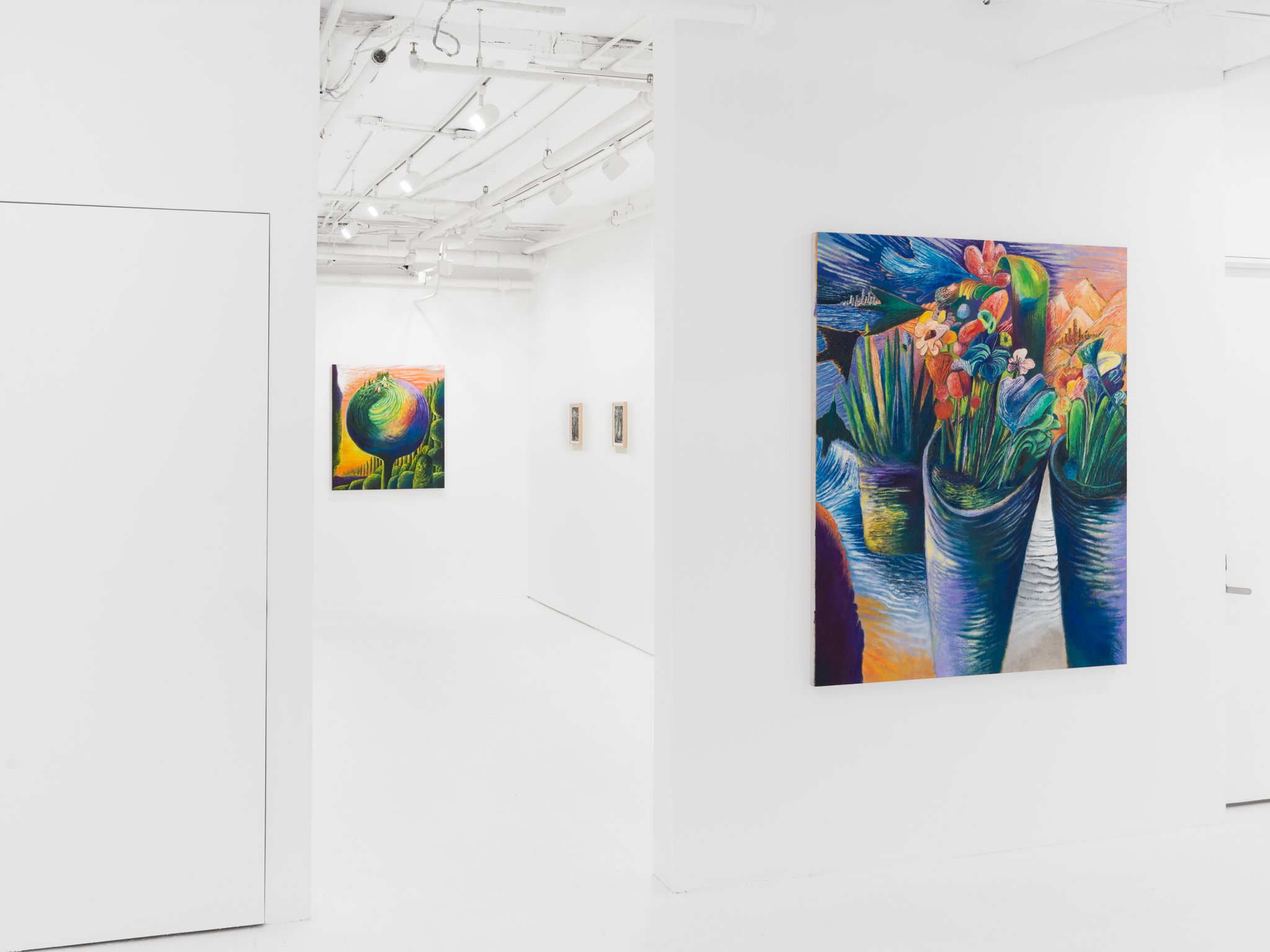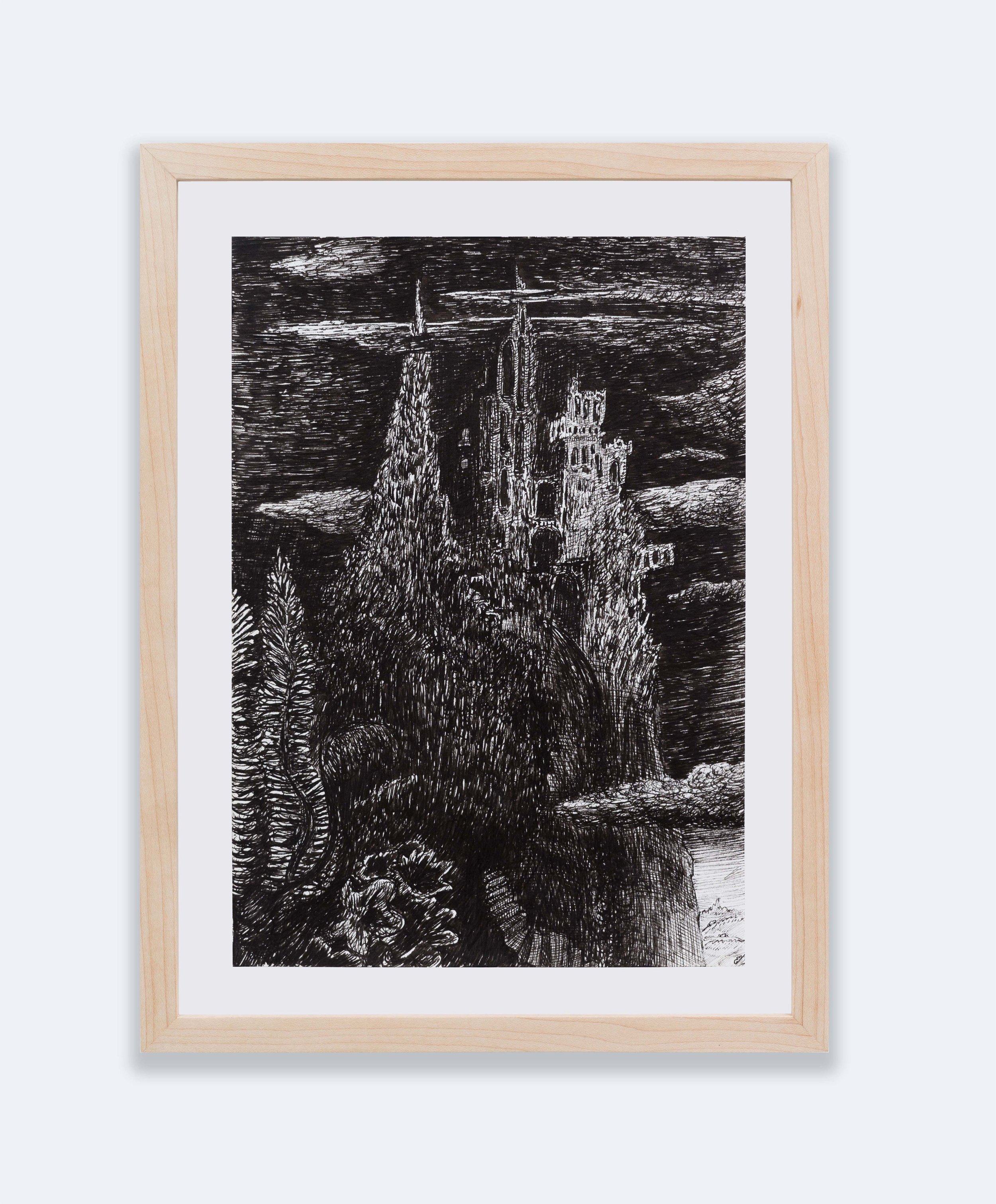Raymie Iadevaia
Nesting in Deep Time
September 8th – October 21st, 2023
In Nesting in Deep Time, yearning becomes a question of proximity. For this new series of paintings, Iadevaia collapses various locales, both referential and imaginary, to muddy the binaries between intimacy and estrangement. Lush topiary gardens, ancient bridges, and towering rock formations share the same spatial plane as the New York City skyline, its contours emerging hazily like a mirage from the Emerald City. New landscapes form as the situations get stranger. Raymie’s paintings unfold like a choose-your-own-adventure, a swirling fantasmic soup that evokes as much Piranesi as it does the “blurred edges” of the Impressionists. Modigliani-coded cats, foxes and coyotes nestle in the foliage like statued sphinxes, and beckon us towards a wayward path. Lush flowers, playfully dancing around anatomical accuracy, threaten to spit water if you meander too close. Just as I am about to alight to what may lead somewhere, the stairs shift, leaving me dizzied; an Escherian-non-sequiter. Amidst these intricately crafted landscapes, remnants of human presence emerge as mere byproducts—an airborne helicopter, airplanes traversing the sky, and decorative clay pots that bear witness to our interventions.
Much of the collapse of compositional boundaries developed out of the pandemic, when, like many of us, Iadevaia found himself contained within the confines of home. Daily drawings became a ritual to both mark time and position oneself, recording the view from the hybrid space of his dining room studio, the window frame as viewfinder. From this locus of imposed stillness, the fountain pen traces pathways that the body is not yet able to traverse, envisioning a convergence of what is and what could be. Upon entering the exhibition, one encounters six of these drawings, wrought in monochrome using the starkness of black ink on paper, a caliginous counterbalance to the vivacity from the oil on panels in the main room. Here, Iadevaia’s interest in the repetivity and tactility of mark making is palpable. The drawings present almost like carvings, a meditative process where elements emerge within the interplay of gestural marks and intersecting cross-hatches. This obsessive record-keeping too permeates Iadevaia’s paintings, the resulting works skillfully oscillating between the realms of drawing and painting. The backgrounds are often rubbed into smoggy ambiguity, lime-green orbs of lantern-cast light emerging from gauzy foregrounds. Dry oil paint is daubed, blended, rubbed and scraped onto the surface in sumptuous layers, endowing the work with a chalkiness that makes one stumble. From these atmospheres, each form diverts from its designated place, interfering with the other’s edges.
Throughout the paintings, a fixed focal point eludes us, encouraging the eye to roam through the foliage in a circuitous process of rediscovery–the more we see, the more we look. Iadevaia positions us as omniscient viewers, loosening the logic to allow us to engage the works as if in our own enigmatic dreamscapes, a nocturnal realm entangled with desires, longings, and seemingly impossible aspirations.
Raymie Iadevaia The Alcove, 2023 Oil on wood panel 40 x 36 inches
Raymie Iadevaia June's Feathers, 2023 Oil on wood panel 36 x 30 inches
Raymie Iadevaia City in the Clouds, 2023 Oil on wood panel 36 x 30 inches
Raymie Iadevaia Summerland, 2023 Oil on wood panel 40 x 36 inches
Raymie Iadevaia Tidings, 2023 Oil on wood panel 60 x 50 inches
Raymie Iadevaia Crystal Street, 2023 Oil on wood panel 60 x 50 inches
Raymie Iadevaia It's Only a Dream, 2023 Oil on wood panel 60 x 72 inches
Raymie Iadevaia A Calico Wind, 2023 Oil on wood panel 60 x 72 inches
Raymie Iadevaia Jasmine, 2023 Oil on wood panel 36 x 40 inches
Raymie Iadevaia Moonflowers, 2023 Oil on wood panel 30 x 36 inches
Raymie Iadevaia Superbloom, 2023 Oil on wood panel 50 x 60 inches
Raymie Iadevaia Nesting in Deep Time, 2023 Oil on wood panel 36 x 40 inches
Raymie Iadevaia Little Things, 2023 Oil on wood panel 50 x 60 inches
Raymie Iadevaia In a Little House with the Summer Oil on linen 10 x 12 inches
Raymie Iadevaia Driftwood, 2022 Oil on wood panel 12 x 16 inches
Raymie Iadevaia Clouds (4/15/22 - 4/18/22), 2022 Ink on paper 12 x 9 inches
Raymie Iadevaia Morning Light (2/5/22 - 2/10/22), 2022 Ink on paper 12 x 9 inches
Raymie Iadevaia The Bridge (2/26/22 - 3/5/22), 2022 Ink on paper 12 x 9 inches
Raymie Iadevaia The Conversation (3/5/22 - 3/7/22), 2022 Ink on paper 12 x 9 inches
Raymie Iadevaia Gatherers (10/14/22 - 10/23/2), 2022 Ink on paper 12 x 9 inches
Raymie Iadevaia On the edge of the void, they had all that they needed (1/23/22 - 1/24/22), 2022 9 x 12 inches


































